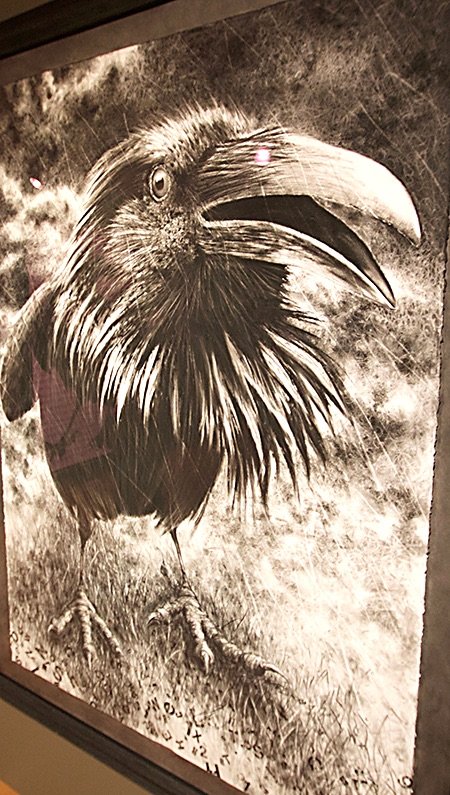A stunning, 6-foot-tall raven drawing greets those walking into this year’s Birds in Art exhibit. Farther in, an 8-foot-long sculpture of a dead raven constructed of tire scraps lies on the floor, conveying a disturbing yet fascinating message of environmental concerns.
Around the dead raven is an emotionally gripping installation of 365 pieces, “Ergo Sum: A Crow a Day,” a mixed-media creation honoring the artist’s mother who has advanced dementia.

These spectacular works by this year’s Birds in Art master artist Karen Bondarchuk add an unusually powerful punch to the Woodson Art Museum’s famed annual exhibit, which features the works of 111 other international artists.
t’s not that Bondarchuk doesn’t like red cardinals or flitting goldfinches. But corvids—the bird family that includes crows, ravens and magpies—have long been her passion, and a natural subject for an artist who likes to work in charcoal as well as sculpture.
Bondarchuk’s dead raven piece, “Lassitude,” was made of tire scraps found along highways in Michigan where she teaches art at Western Michigan University in Kalamazoo. It was a similar assemblage of tire pieces, “Corvus Deflatus,” that first got her into her first Birds in Art exhibition, in 2008. It was such a departure from the usual paintings and sculptures that regulars to Birds in Art still remember it.
With the exception of 2009, she’s been part of the exhibit ever since, always adding her distinct brand of intellectual thoughtfulness to the galleries. The master artist honor is “richly deserved” says museum director Kathy Foley, who describes Bondarchuk as “an artist of exceptional talent, originality and profound thought.”
She was first drawn to corvids because of their intelligence, sophistication and ability to adapt to human environments. It’s fascinating to her that crows not only use tools (to extract insects, for example) but also make tools. She tells of crows that have been observed removing twigs from a branch to create a hooked shaft. Given a straight piece of wire, crows are known to bend a hook shape into one end and use the tool to drag food within reach through a fence.
Bondarchuk once met a young raven that was too weak to fly as a fledgling, so its parents somehow enticed the nearest humans half a mile away to follow them into the woods. The people found the sick young bird, took it in, and released it a few weeks later. It still visits occasionally.
She’s intrigued by their mischief as well, printing capsule descriptions of their thievery and disruption in the background of her tallest drawing displayed in Birds in Art.
It’s a testament to her talent that Bondarchuk so effectively conveys the human experience through her profound, complicated representation of these animals. She chose crows for her 365-piece homage to her mother because crows are birds people tend to ignore. “Ergo Sum: A Crow a Day” marks the passage of time her mother no longer recognized and reminds us of the preciousness and individuality of each day—some days quirky and cheerful, others more sober.
Begun on Aug. 1, 2014, “Ergo Sum” also represents a labor of love that Bondarchuk likens to the repetitiousness of motherhood. In other words, a stunning combination of the common and the extraordinary, which viewers will find aplenty throughout Birds in Art.
Birds in Art is on display through Nov. 27. Admission is free. Gallery open Tues.–Fri. 9 am–4 pm, Thurs. until 7:30 pm during BIA, and Sat.-Sun. noon–5 pm.




